
ESA Top Multimedia
Artemis II Orion in all its glory

At NASA’s Kennedy Space Center in Florida, USA, the Orion vehicle that will be used for Artemis II is getting ready for this first mission to bring humans around the Moon and back in over 50 years.
The vehicle consists of several parts: the conical crew module on top, where the four astronauts will live during the mission; the crew module adapter directly beneath it, connecting the crew module above and service module below; the cylindrical European Service Module, the powerhouse of Orion providing the crew vehicle with electricity, propulsion, thermal control, air and water; and the conical spacecraft adaptor, which connects Orion to the Space Launch System mega Moon rocket.
The Artemis II vehicle stack was moved into a vacuum chamber at the Kennedy Space Center, where it will undergo several tests to ensure it can withstand the harsh conditions of space. The electromagnetic compatibility and interference tests as well as high-altitude vacuum tests will take place in one of two historical chambers also used to test spacecraft during the Apollo era.
Space Team Europe for Ariane 6: Michel Bonnet
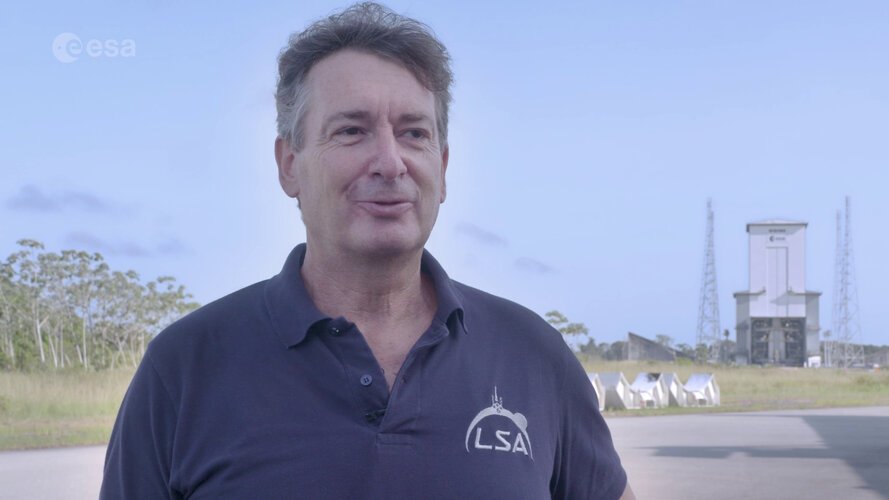
They say it takes a village to raise a child. To launch a rocket, we have the combined expertise and passion of Space Team Europe. Michel Bonnet is one of many making the first Ariane 6 launch possible, and has been interviewed as part of a series highlighting some of the people that make up this dream team.
“Who has not dreamed of working in the space sector?” he says, recalling how he built small rockets as a teenager using sodium chlorate, sulphur and sugar. In 1995, after years of work with helicopters and nuclear submarines, Michel started work in the space sector. For Ariane 6’s first flight, he is the Inaugural Flight Principal covering mission preparation, including the several small satellites being launched, and the launch campaign follow-up.
Michel is also head of a team of six engineers who are together working on the future possibilities for Ariane 6, often focussing on potential exploratory missions after 2030 and what modifications would be necessary to the launcher to make them feasible.
Stay tuned for more from #SpaceTeamEurope: an ESA space community engagement initiative to gather European space actors under the same umbrella sharing values of leadership, autonomy, and responsibility.
Find more videos from Space Team Europe.
Simulating tumbling reaction wheel reentry
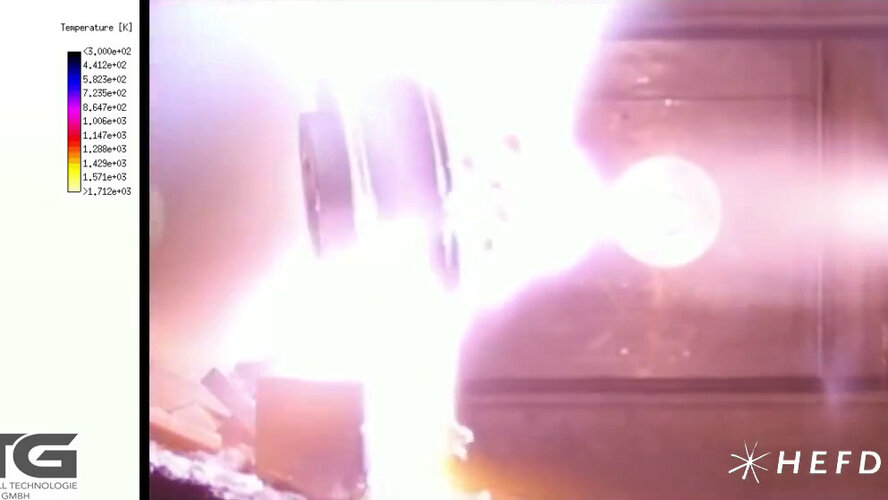
A reaction wheel – one of the heaviest parts of a space mission, its changing rotation used to shift a satellite’s orientation – seen in a plasma wind tunnel belonging to the High Enthalpy Flow Diagnostics Group (HEFDiG) at the University of Stuttgart Institute of Space Systems (IRS). Arc-heated gas in the test chamber reaches speeds of several kilometres per second, reproducing reentry conditions, while the reaction wheel itself is being rotated, reproducing the tumbling that takes place as a satellite plunges through the atmosphere.
The reaction wheel itself comes from Collins Aerospace in Germany, which has supported Design for Demise (D4D) activities for many years and introduced several modifications to their TELDIX reaction wheel making it more likely to come apart during satellite reentry in support of demisability.
This test clip was presented during this year’s Space Mechanisms Workshop at ESA’s ESTEC technical centre in the Netherlands, focused on current and future requirements and guidelines to reduce the risk from orbital debris, including ESA’s Zero Debris Charter. The event was attended by more than 130 space mechanisms specialists from European industry and academia.
Proba-2 sees the Moon eclipse the Sun
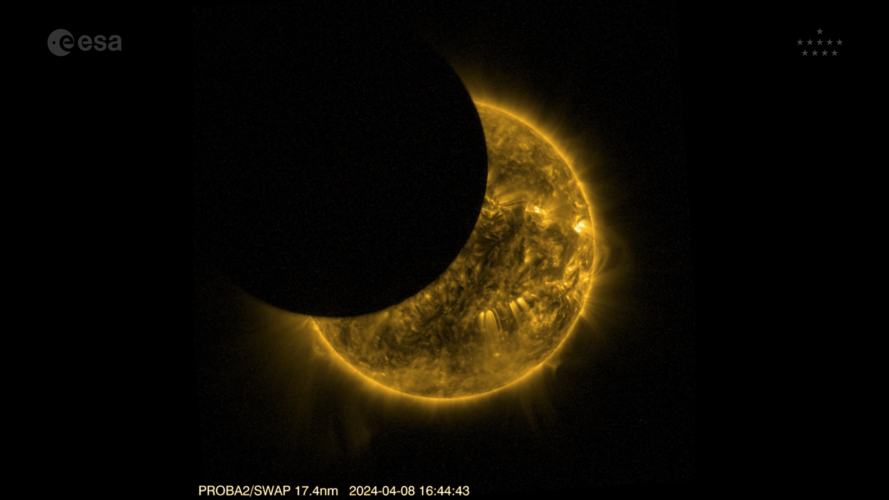
ESA’s Proba-2 captured two partial solar eclipses on 8 April 2024.
A solar eclipse occurs when the Moon passes between Earth and the Sun, totally or partially blocking the Sun from Earth’s point of view. On 8 April, lucky viewers across North America witnessed the Moon blocking out the Sun in its entirety for a few minutes, while those north and south of the ‘total eclipse path’ witnessed a partial eclipse.
Throughout the eclipse period, the Moon crossed Proba-2’s field of view twice, appearing as a partial solar eclipse. The satellite flies around 700 km above Earth’s surface in what is called a Sun-synchronous orbit, each orbit lasting around 100 minutes.
The video was produced from images taken by Proba-2’s SWAP telescope, which observes the Sun in extreme ultraviolet light. At these wavelengths, the turbulent nature of the Sun's surface and corona – the Sun's extended atmosphere – become visible. These measurements have to be made from space, because Earth’s atmosphere doesn’t allow such short wavelengths of light to pass through.
A total solar eclipse provides a unique opportunity to see the Sun’s corona from Earth's surface, using visible light. As the Moon blocks most of the Sun’s bright light, the faint corona can be discerned. By comparing the SWAP ultraviolet images to what is seen by (visible light) telescopes on Earth, we can learn about the temperature and behaviour of different structures in the corona.
Other solar missions also made the most of the unique measurement opportunities provided by the eclipse. For example, ESA’s Solar Orbiter was positioned close to the Sun and at a 90-degree angle from Earth’s view throughout the eclipse. This allowed it to complement Earth-based observations by monitoring the Sun’s corona side-on, including any solar eruptions pointing in Earth’s direction.
Total solar eclipse seen from space
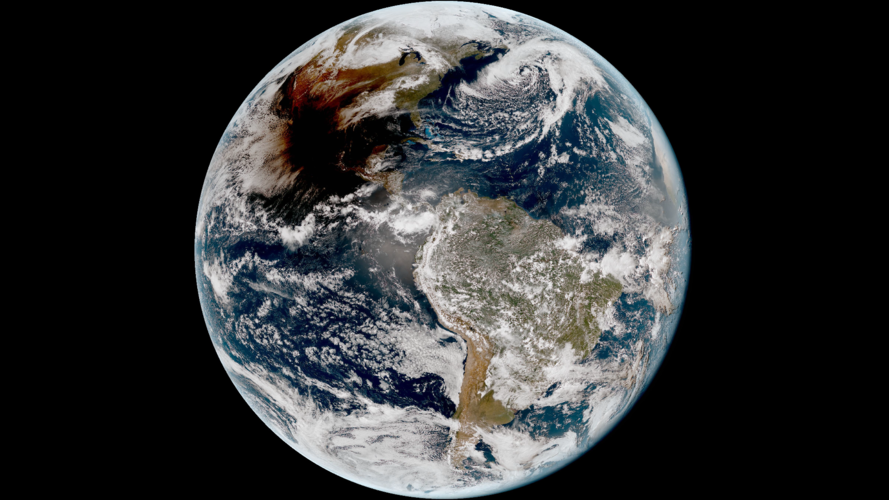
A total solar eclipse swept across North America yesterday, blocking out the Sun momentarily with parts of the continent plunged into darkness. Geostationary satellites orbiting 36 000 km away captured images of the rare celestial event.
These images, captured by the Geostationary Operational Environmental Satellite (GOES-16), captured the moon’s shadow moving across North America from approximately 16:00 to 23:00 CEST (15:00 to 22:00 BST.)
A total solar eclipse occurs when the Moon passes between the Sun and Earth and, for a short period, blocks the face of the Sun, save for a visible ring of light, known as the Sun’s corona.
The track of the moon’s shadow across Earth’s surface, called the path of totality, spanned across the North American continent – from Mexico to the very eastern tip of Canada.
The GOES series is a collaborative development and acquisition effort between National Oceanic and Atmospheric Administration (NOAA) and NASA. The GOES-16 (GOES-East) satellite, the first of the series, provides continuous imagery and atmospheric measurements of Earth's western hemisphere and monitors space weather.
The Copernicus Sentinel-3 mission also captured images of the eclipse with its Sea and Land Surface Temperature Radiometer (SLSTR).
The eclipse also acts as a laboratory for researching what happens to weather when the Moon’s shadow passes over. The shadow makes air temperatures drop and can cause clouds to evolve in different ways. Data from GOES, Sentinel-3 and other satellites are now being used to explore these effects.
Biological resistance vibration test

The video shows a biological tolerance test, where the aquarium including three shrimps is submitted to vibrations. The goal was to determine the survivability of the species during the rocket launch and flight until delivery to the ISS. These tests, performed in June 2023, were successful as the shrimps showed remarkable resilience to simulated launch conditions.
Solar eclipses – and how to make them
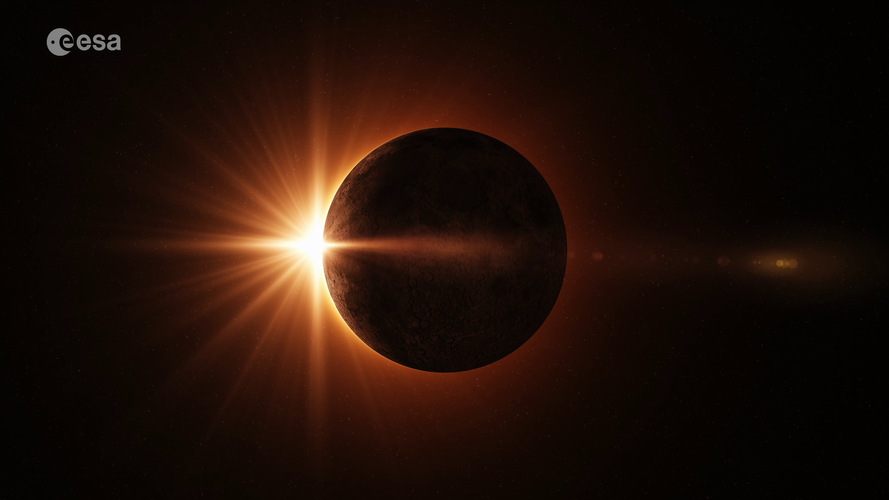
During a solar eclipse the Earth is plunged into darkness and the Sun’s ghostly atmosphere becomes visible. Scientists travel the globe to experience total solar eclipses, which occur for just a few minutes at a time every 18 months or so. But what exactly causes solar eclipses, and how do scientists try to make their own, including with ESA’s new Proba-3 mission?
Astro Chat with Pablo Álvarez Fernández | ESA Explores podcast
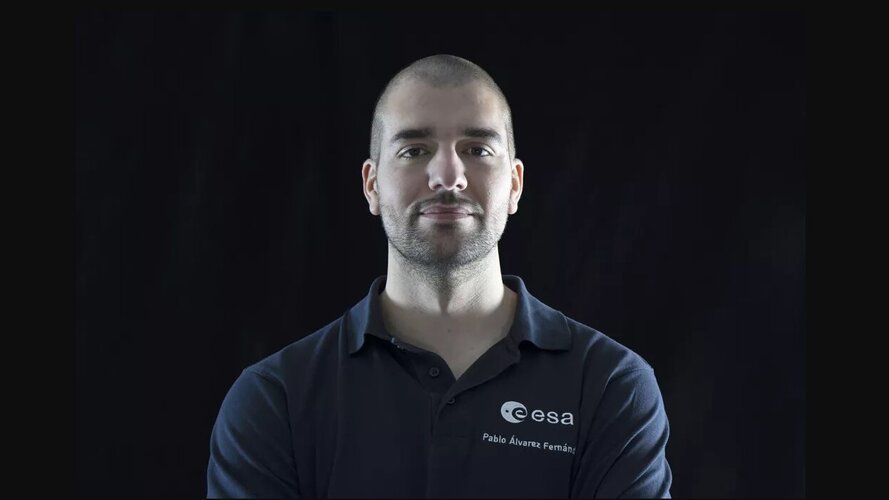
Pablo Álvarez Fernández, one of ESA's five astronaut candidates currently undergoing basic astronaut training at the European Astronaut Centre in Cologne, Germany, shares his experiences in astronaut training, his favourite lessons, and his view on the future of space exploration. Also, stay tuned to hear his favourite space-related quote and movie!
This is Episode 5 of our ESA Explores podcast series introducing the ESA astronaut class of 2022, recorded in November 2023.
Music and audio editing by Denzel Lorge. Cover art by Gaël Nadaud.
Ariane 6 tests towards first flight
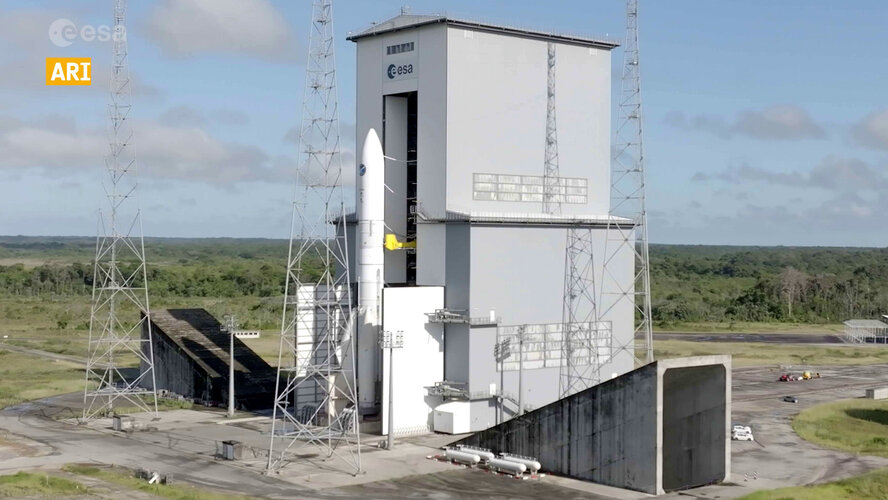
Europe’s next rocket, Ariane 6, passed all its qualification tests in preparation for its first flight, and the full-scale test model has been removed from the launch pad to make way for the real rocket that will ascend to space.
The test model at Europe’s Spaceport in Kourou, French Guiana, stood 62 m high. It is exactly the same as the ‘production model’ Ariane 6 rockets that will soon be launched, except that its boosters do not need to be tested as part of the complete rocket, so the boosters are not fuelled.
Teams preparing Ariane 6 for its inaugural flight successfully completed for the first time a launcher preparation and countdown sequence, on 18 July. Representatives of ESA, Ariane 6 prime contractor ArianeGroup and launch base prime contractor and test conductor CNES completed important objectives for system qualification and performed a series of actions fully representative of a launch chronology.
The launch simulation included the removal of the mobile gantry, the chill-down of ground and launcher fluidic systems, the filling of the upper and core stage tanks with liquid hydrogen (–253°C) and liquid oxygen (–183°C), and at the end of the test, the successful completion of a launch chronology up to the ignition of the Vulcain 2.1 engine thrust chamber by the ground system.
On 5 September 2023 the Vulcain 2.1 engine was ignited, fired for four seconds as planned and switched off before its liquid oxygen and liquid hydrogen fuels were drained to their separate underground tanks. The exercise showed again that the system can be kept safe in the event of a launch abort, as already demonstrated during the 18 July test.
A nighttime full-scale wet rehearsal for Ariane 6 was completed on 24 October 2023, the rocket was fuelled and then drained of its fuel. The test lasted over 30 hours with three teams working in shifts of 10 hours each.
A major full-scale rehearsal was conducted on 23 November 2023 in preparation for its first flight, when teams on the ground went through a complete launch countdown followed by a seven-minute full firing of the core stage’s engine, as it would fire on a launch into space.
A third combined test loading occurred on 15 December 2024 that included a launch countdown to qualify the launch system in degraded conditions and ensure its robustness in preparation for operations. This test sequence included qualification tests of several launch system functions in case of aborted launch and included one ignition of the Vulcain 2.1 engine thrust chamber. It was the fifth countdown run to include loading Ariane 6 with cryo-propellants since July.
On 30 January 2024, the cryogenic connection system passed a last system test of the liftoff disconnection operations lines – the yellow arms supporting the fuel lines to the upper stage to power the Vinci orbital engine. Simultaneously at the bottom of the central core the connection system for the main stage also disconnected.
On 5 February, it was the turn of the electrical umbilical lines to be disconnected. These lines supply the launcher and the satellites inside Ariane 6 with electrical power but also host the digital signals for communications with the informatics system as well as carrying sensor information to ensure the flight system is in good shape for liftoff.
The largest components for the first flight model of Europe’s new rocket Ariane 6 arrived at the port of Pariacabo in Kourou, French Guiana on 21 February 2024 via the novel ship, Canopée (canopy in French). The Ariane 6 stages and components are all manufactured across Europe.
The two central stages for Ariane 6’s first flight were then assembled in the launcher assembly building (BAL) at Europe’s Spaceport. The core stage and the upper stage for Europe’s new rocket Ariane 6 are set to fly in the Summer of 2024. Once assembled, the stages will be transferred to the launch pad.
Episode 1 – Scouting the Red Planet
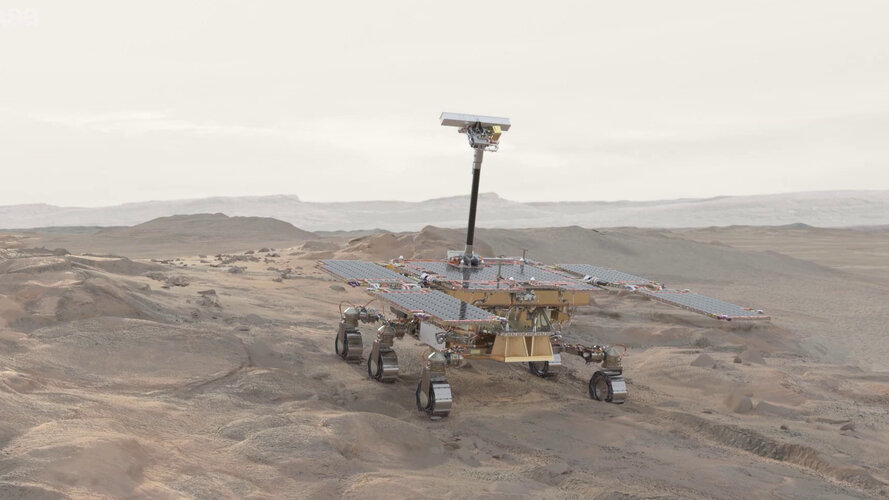
Watch the first episode of the ExoMars Rosalind Franklin rover mission – Europe’s ambitious exploration journey to search for past and present signs of life on Mars.
This episode starts after a successful descent and landing on the Red Planet in 2030.
Rovers on Mars have previously been caught in loose soils, and turning the wheels dug them deeper, just like a car stuck in sand. To avoid this, Rosalind Franklin has a unique wheel-walking locomotion mode to to overcome difficult terrains, as well as autonomous navigation software.
A major goal of the mission is to understand the geological context and identify minerals formed in the presence of water that could be good targets for drilling into and collecting samples for analysis.
The scientific eyes of the rover are set atop the mast on the Panoramic Camera suite, known as PanCam. From its vantage point about two metres above the ground, PanCam cameras come into play to get a whole picture of the site with high resolution imaging.
Enfys, meaning rainbow in Welsh, is an infrared spectrometer to study mineral composition. Enfys and PanCam work in synergy. PanCam is used to obtain colour, visual information of what lies around the rover. Enfys’ job is to inform scientists what the minerals are.
Rosalind Franklin will be the first rover to reach a depth of up to two metres deep below the surface, acquiring samples that have been protected from surface radiation and extreme temperatures.
The mission will serve to demonstrate key technologies that Europe needs to master for future planetary exploration missions.
This episode shows the spacecraft, the rover and martian landscapes are as true to reality as possible for a simulation.
Check ESA’s ExoMars website and our frequently asked questions for the latest updates.
Credits:
Production: Mlabspace for ESA
3D animation: ESA/Mlabspace
Video footage: ESA/NASA, Shutterstock
Music composed by Valentin Joudrier
Information session on the outcome of ESA's 323rd Council
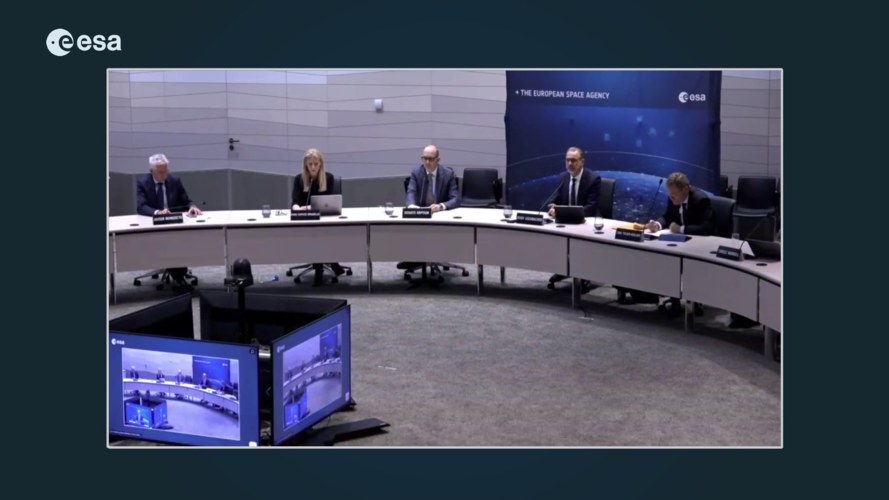
ESA Member States met in Paris, France, for the 323rd session of the ESA Council on 26 and 27 March 2024.
Watch the replay of the information session in which ESA Director General Josef Aschbacher and ESA Council Chair Renato Krpoun share the outcome of the meeting. They gave an update to media about ESA's vision for the European space sector by 2040 and the status of actions provided in the roadmap for the implementation of the Resolution on present and future European Space Transportation.
They also addressed the progress made in addressing critical challenges faced by ESA in preparation for the next Ministerial Council in 2025. This includes the establishment of the Independent Project Management Authority (IPMA), updating procurement and geo-return rules, service procurement and agreements with Member States.
ESA School Days 2024 at ESRIN

Dall’11 al 15 marzo, oltre 1.400 giovani studenti e studentesse si sono ritrovati al Centro ESA a Frascati, dedicato all’Osservazione della Terra, per l’edizione 2024 degli ESA School Days. Il Centro ESRIN ha accolto le scuole primarie (quarta e quinta classe) nei giorni 11, 12 e 13 marzo, mentre gli ultimi due giorni della settimana sono stati dedicati alle scuole medie. Durante cinque giorni di presentazioni e laboratori pratici, le scuole provenienti da tutta Italia hanno avuto l’opportunità di esplorare la vasta gamma di attività spaziali che si svolgono nel sito dell’ESA.
L’iniziativa, che ha visto la partecipazione di ESERO Italia e dell’Agenzia Spaziale Italiana (ASI), si propone l’obiettivo di coinvolgere e ispirare le prossime generazioni di studenti e studentesse STEM, diffondendo conoscenza sullo Spazio e sull’Agenzia Spaziale Europea.
From 11 to 15 March, over 1400 young students gathered at ESA Centre for Earth Observation in Frascati for the 2024 edition of ESA School Days. ESRIN welcomed primary school students (4th and 5th grades) on 11, 12 and 13 March, while the last two days were dedicated to secondary schools. During these five days of presentations and laboratories, schools from across Italy had the opportunity to explore the wide range of space activities carried out at ESA’s establishment.
The initiative, that saw the participation of ESERO Italia and the Italian Space Agency (ASI), aims to engage and inspire the next generation of STEM students, while sharing knowledge about space and the European Space Agency.
Oxia Planum geological map

A team of European scientists have published the most detailed geologic map of Oxia Planum – the landing site for ESA’s Rosalind Franklin rover on Mars. This thorough look at the geography and geological history of the area will help the rover scout the once water-rich terrain, in the search for signs of past and present life.
The map gives scientists a head start before Rosalind Franklin lands there in 2030. Four years in the making, this map identifies 15 geological units with characteristic features that can help decide how the rover explores the area, interprets its surroundings, and tries to collect evidence of primitive life.
Oxia Planum is located near the martian equator and contains sedimentary deposits that are nearly four billion years old.
The map includes the main types of bedrock, and structures with distinct shapes like ridges and craters. It even features the material that rests on top, for example blown by the wind, or thrown long distances when meteorites impacted the surface. The shape model of the surface on which the map is shown here was generated from orbital images by a painstaking process. In some places, long and straight ‘stripes’ can be seen as a result of this processing.
Data came from the Colour and Stereo Surface Imaging System (CaSSIS) onboard the ExoMars Trace Gas Orbiter and several instruments on NASA’s Mars Reconnaissance Orbiter (MRO), including the HiRISE camera, which returns images from Mars orbit at 25 cm per pixel.
For more information, visit the ExoMars website: www.esa.int/exomars.
Toward the next generation of air quality monitoring

Air pollution is the largest environmental health risk in Europe and significantly impacts the health of the European population, particularly in urban areas.
Following on from the Sentinel-5P satellite – the first Copernicus mission dedicated to monitoring our atmosphere – the Sentinel-4 and Sentinel-5 missions will take current air quality measuring capabilities to the next level.
Together, the Sentinel-4 and -5 missions will provide information on atmospheric variables in support of European policies. This will include the monitoring of air quality, stratospheric ozone and solar radiation, and climate monitoring.
This video features interviews with Giorgio Bagnasco, Sentinel-4 Mission Project Manager, Ben Veilhelmann, Sentinel-4&5 Mission Scientist and Didier Martin, Sentinel-5 Mission Project Manager.
Simulation of a Milky Way-like galaxy forming

This simulation shows how a galaxy like the Milky Way forms and evolves through time. It runs from the birth of the Universe (13.7 billion years ago) to 3 billion years ago.
The forming galaxy begins as a clump of dark matter threads that knit together; gas and stars then begin to form along these bright veins as time ticks on. A major event in the Milky Way’s history is also labelled at around one minute in, when another object collided with the infant Milky Way.
Gas is shown in blue, stars in white, dark matter in red, and iron in green, as indicated by the labels displayed at bottom left. In the bottom right, the amount of time ago is shown via both the ‘z’ label (referring to redshift), and the ‘GYR’ label (with 1 Gyr, or gigayear, equalling 1 billion years).
The simulation was produced by Florent Renaud as part of his Vintergatan Project (Vintergatan being the Swedish word for ‘Milky Way’, meaning ‘The Winter Street’).
Andreas Mogensen at Ellington

ESA astronaut Andreas Mogensen stepping out of the plane at Ellington Field, Texas, US after splashing down with Crew-7 earlier that day.
ESA astronaut Andreas Mogensen flew with his Crew-7 crewmates Jasmin Moghbeli (NASA), Satoshi Furukawa (JAXA), and Konstantin Borisov (Roscosmos) to Ellington Field near Houston, Texas, US, after spending six months on the International Space Station and returning to Earth in the Dragon Endurance.
Crew-7 splashed down off the coast of Florida, US, close to Pensacola, at 09:47 GMT/10:47 on 12 March 2024, following a nearly 19-hour journey after undocking from the Space Station.
Andreas spent 199 days in space during his Huginn mission, 197 of them on the Space Station. During this time, he conducted more than 30 European experiments and technology demonstrations, as well as many international ones. From filtering waste water and figuring out astronauts’ sleep in space, to capturing the image of a special lightning called a red sprite, Andreas shared the science he conducted with the world through his social media, l like the mythical bird that gave its name to his mission
Huginn is named after one of the two ravens of the Norse god Odin, the other being Muninn. According to Norse mythology, the two ravens are said to fly into the world every day, gathering information and relaying it to Odin at the end of the day, telling him what they have seen across the globe.
The return of Andreas Mogensen | Huginn Mission

After more than 6 months on the International Space Station, ESA astronaut Andreas Mogensen returned to Earth, marking the end of his Huginn mission. It was his second mission to the Space Station and his first long-duration, where he was the pilot of Crew-7, which consisted of Jasmin Moghbeli (NASA), Satoshi Furukawa (JAXA), and Konstantin Borisov (Roscosmos).
Thumbs up from Andreas Mogensen

ESA astronaut Andreas Mogensen after exiting the Dragon Endurance, that brought him and Crew-7 back from the International Space Station. Andreas was on his Huginn mission, his second space flight, and his first long-duration mission to the International Space Station.
Andreas Mogensen and Crew-7 in Dragon after return to Earth

ESA astronaut Andreas Mogensen together with Crew-7 after their return to Earth. The Dragon splashed down at 09:47 GMT/10:47 CET on 12 March after undocking from the International Space Station on 11 March at 15:20 GMT/16:20 CET.
From left to right: Konstantin Borisov, Andreas Mogensen, Jasmin Moghbeli, and Satoshi Furukawa.
The Whispering of Huginn
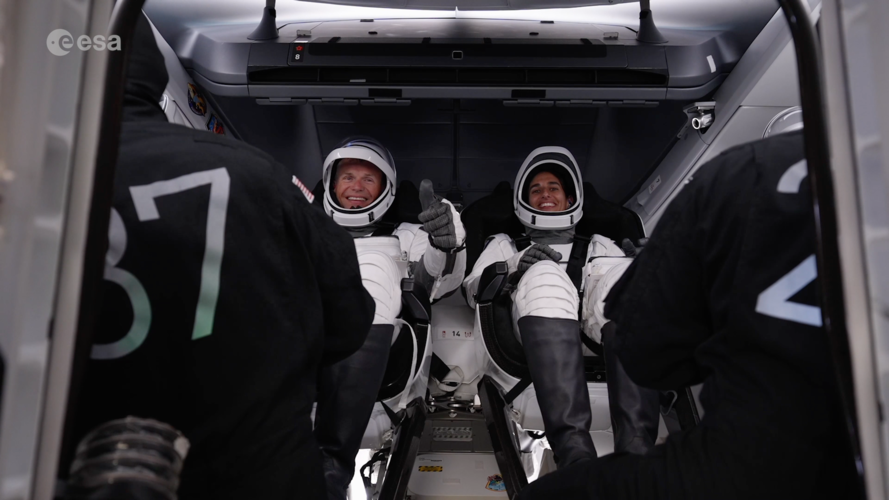
Andreas Mogensen launched on his Huginn mission in August 2023 to the International Space Station, becoming the first non-US astronaut to pilot SpaceX’s Crew Dragon spacecraft. Andreas became commander of the International Space Station in September 2023, becoming the longest serving European commander in January 2024. His mission was spent on more than 30 European experiments and plenty of international ones as well, ranging from water purification to studies of human physiology and thunderclouds. After 6 months on the International Space Station, Andreas will come down to Earth together with his Crew-7 crewmates Jasmin Moghbeli (NASA), Satoshi Furukawa (JAXA), and Konstantin Borisov (Roscosmos).
Virtual Reality for body and mind
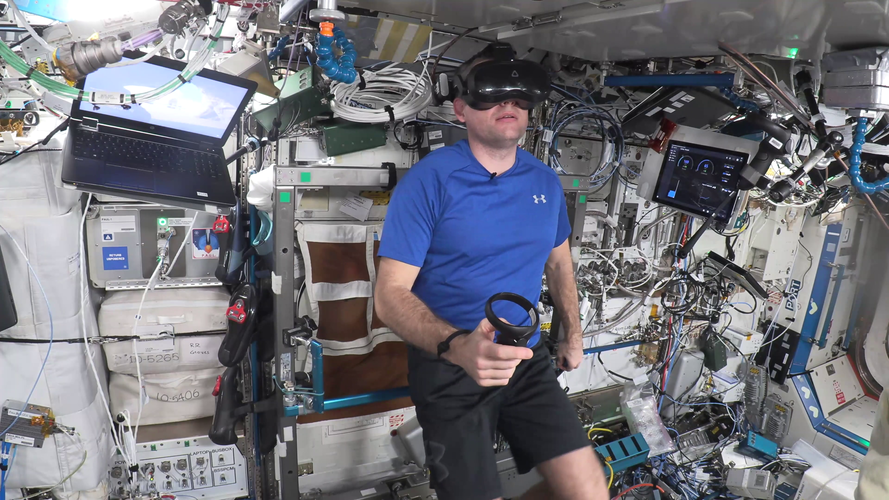
ESA astronaut Andreas Mogensen explains how two experiments involving virtual reality makes on International Space Station. The first is Virtual Assistance Mental Balance (VAMB) where Andreas gets to enjoy a calm setting in nature that helps him relax. The second one is VR for Exercise, where he cycles on the Space Station’s exercise bike and through different bike routes in Denmark on the VR headset, which has quickly become a favourite for Andreas.
Andreas Mogensen and Marcus Wandt in Columbus
 Two Scandinavians in space
Two Scandinavians in spaceMuninn Mission highlights
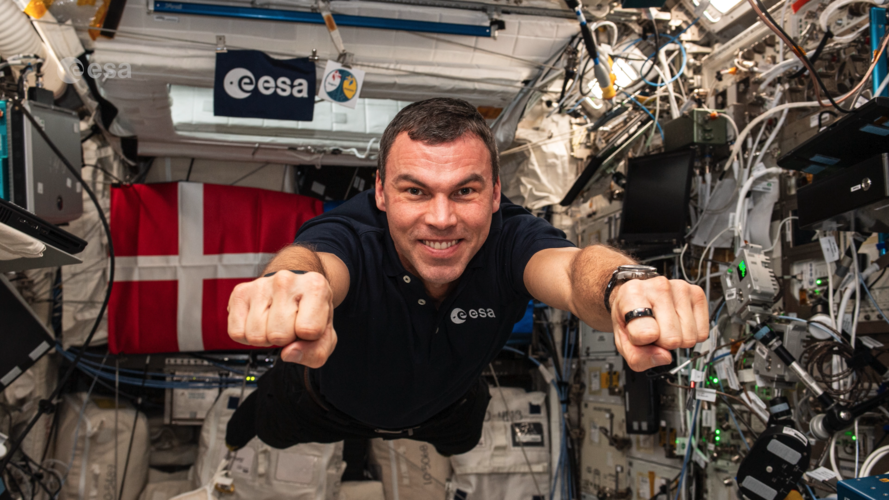
Highlights of the Muninn mission with ESA project astronaut Marcus Wandt, from the countdown to launch, to his work on the International Space Station and the return to Earth.
Axiom Mission 3 crew in space

Axiom Mission 3 crew in the European-built Cupola on the International Space Station. Clockwise, ESA project astronaut from Sweden Marcus Wandt, Walter Villadei from Italy, Alper Gezeravcı from Türkiye and Michael López-Alegría, a dual US-Spanish citizen.
Two Scandinavians in space
 Two Scandinavians in space
Two Scandinavians in spaceEarth views from Cupola by Marcus Wandt

Join ESA project astronaut Marcus Wandt inside the seven-windowed cupola, the International Space Station's "window to the world".
The ESA - European Space Agency-built Cupola is the favourite place of many astronauts on the International Space Station. It serves not only as a unique photo spot, but also for observing robotic activities of the Canadian Space Agency's robotic arm Canadarm2, arriving spacecraft and spacewalks.
Marcus was launched to the International Space Station on the Dragon spacecraft as part of Axiom Mission 3 on 18 January 2024. His two-week mission on board is known as Muninn.
Follow Marcus’s journey on the Muninn website, check our launch kit in English or Swedish and connect with Marcus on his Instagram and X accounts.
Full house
 Full house
Full houseMarcus and Muninn are flying

ESA project astronaut Marcus Wandt took off on 18 January 2024 as part of the Axiom-3 crew for a 14-day mission to the International Space Station. After 36 hours catching up to the Space Station, the Dragon docked to the Space Station, the seal between the two tested and finally Marcus started his Muninn mission as he entered the International Space Station. ESA astronaut Andreas Mogensen along with the rest of the crew of Expedition 70 was waiting to welcome them to space!
Muninn spreads its wings

ESA project astronaut Marcus Wandt launched together with the rest of the Axiom-3 crew at 22:49 CET on 18 January 2024, from launch pad 39A, NASA's Kennedy Space Center, Florida, USA.
Marcus will start his Muninn mission when he enters the International Space Station on Saturday 20 January, where he will spend up to 14 days conducting science and testing technology that can one day help people on Earth.
You can follow Marcus mission on his social media:
https://twitter.com/astro_marcus
https://www.instagram.com/esaastro_marcus/
And learn more about his Muninn mission on ESA Muninn page:
https://www.esa.int/Science_Exploration/Human_and_Robotic_Exploration/muninn
Liftoff of Axiom Mission 3
 Liftoff of Axiom Mission 3
Liftoff of Axiom Mission 3Page 2 de 3
- Précédente
- 1
- 2
- 3
- Suivante



